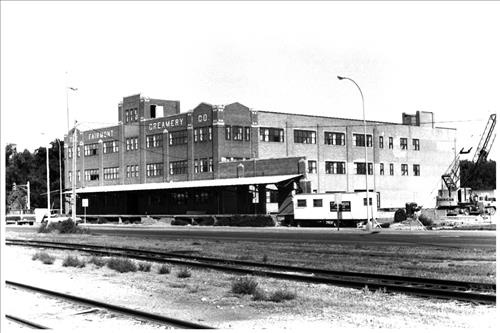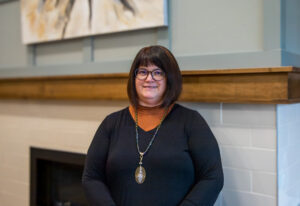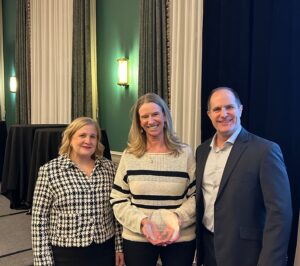MaryBeth (Meyers) Kalvig, 80, moved into The Eventide Living Center in Moorhead in 2022.
Little did she know, her cozy apartment on the second floor stands where her immigrant grandparents’ home once stood in the early 1900s—a happy coincidence.
“Their house was either right here where I live or just a few apartments down from me,” MaryBeth said. “I remember it well. There was a small milk house in the back.”
MaryBeth’s research, borne out of curiosity, uncovers a rich history in the area where Eventide Senior Living Communities in Moorhead is located today.
Meet the Maiers
MaryBeth’s grandparents, Fred and Rose Maier, emigrated from Bessarabia, or what is now Moldova near Ukraine.
“They were chased out by the Tzar of Russia at the time,” MaryBeth said. “It was hard work getting out but they did.”
Once they emigrated and settled in their little home with the milk house in the back, Fred and Rose made a living farming the land, raising cows and chickens—as well as 12 children. Their 600-square-foot shack had just enough land in the back to grow food to eat and sell.
Putting the size of the home into perspective, MaryBeth notes that her cozy Eventide Living Center apartment is about 550-square feet—the perfect size for an active retiree and her cat.
“My dad told me he and his siblings slept in the loft, and that they built a little bedroom for Grandma and Grandpa,” she said. “Dad said it wasn’t hard. They had mattresses and quilts and pillows up there for everyone.”
Although the Maier family did well for themselves, the income from selling produce just wasn’t enough, so Grandpa Fred also worked for the Northern Pacific Railroad.
“He would walk to Main Avenue from here in the winter because there was nothing out here until you reached Main Avenue to pick up the train,” MaryBeth said. So he’d walk a mile or so to the train stop, work nine hours, get dropped off by the train at night and walk home another mile.”

The Fairmont Creamery was one of the area’s largest employers of residents who lived in the area. Contributed photo: Minnesota Historical Society
Life in the neighborhood
Many residents of the area, mostly new Americans who emigrated from northern and eastern Europe, were community farmers who tilled crops in fields located just in their backyards.
Other residents worked at Concordia College or “commuted” by foot to the Fairmont Creamery to spend entire days doing repetitive tasks, such as shelling eggs for pennies a day.
Those who farmed like MaryBeth’s grandparents, sold their produce at local markets, likely in downtown Moorhead where a few grocers had storefronts, according to public records.
“Right around 1900, my family started moving to this area from Bessarabia, which of course is now a part of Ukraine,” MaryBeth said. “Most of the people in the neighborhood were also from parts of eastern Europe and the Scandinavian countries.”

The milk house
The milk house was also a source of income for the Maier family.
“There was a hired man who lived in the milk house, and my dad as a teenager would clean glass milk bottles by hand,” MaryBeth said. “They sold vegetables from a horse-drawn cart, and then one day they realized they could make additional money if they sold butter and cream on the cart.”
After setting up a deal with a cattle farmer in the area, they started purchasing milk to process and pasteurize so people didn’t have to go all the way to the big creamery north of their neighborhood.
MaryBeth’s father and his siblings delivered directly to people’s homes. “He had his own little creamery business on the side,” she said.
MaryBeth’s aunt Maggie Hanson and her husband Alvin also lived on the street, which may have been adjacent to one of the Probstfield family homes in the neighborhood.
Details are difficult to confirm with public records located at the Historical and Cultural Society of Clay County, though even the anecdotal evidence is enough to remind us that there is rich history underneath our feet—wherever we may roam.
For MaryBeth, that evidence is stored in her memory. “When I moved in here, I kept thinking about how this area looked so familiar because of Concordia, and then I realized, boy, I’m really close to Grandma and Grandpa’s.”
‘It was their life to work’
We asked MaryBeth if she remembers visiting her grandparents in their little Moorhead home.
“Oh, yes! We went to see Grandma and Grandpa on the weekends and that was just the way they were. It was their life to work, and that’s kind of the way it was back then,” she said.
MaryBeth remembers her grandmother’s strong eastern European accent and the smell of the coal oven that cooked food and kept the house warm.
Eventually, Fred and Rose Maier moved to warmer climes in California, and in the years to come, their neighborhood with the little farms and the milk house and the horse-drawn carts were replaced by bigger homes, cars and commerce.
Yet, while the historic neighborhood certainly looks different, what hasn’t changed is the sense of community, which is as bustling and alive as it’s ever been right here at Eventide.
Do you have a story to share about the history of an Eventide location?
Our curiosity is piqued, and so are our residents’. If you have information about the history of your nearest Eventide location, we’d love to hear from you. Please contact Carrie at carrie.carney@eventide.org to share your story.



